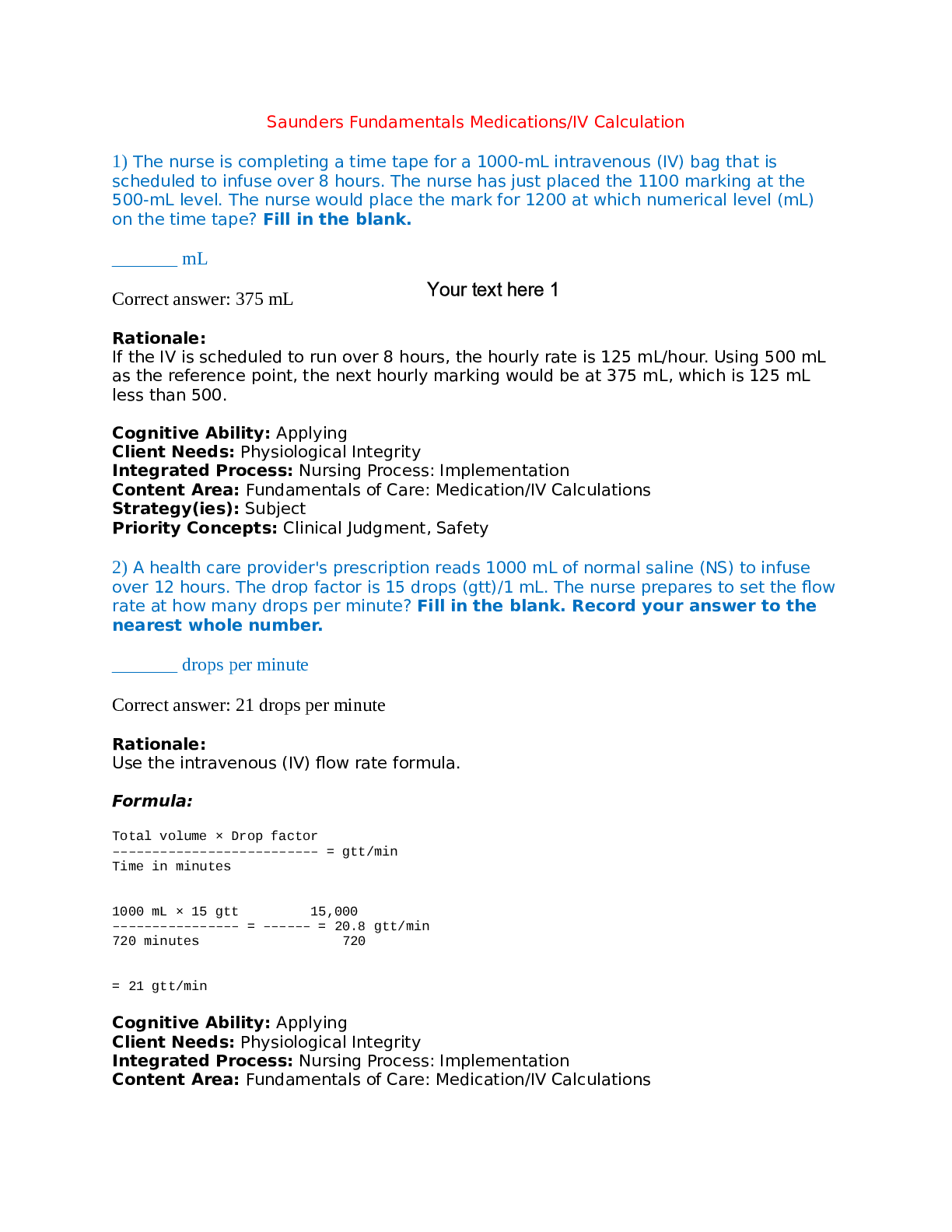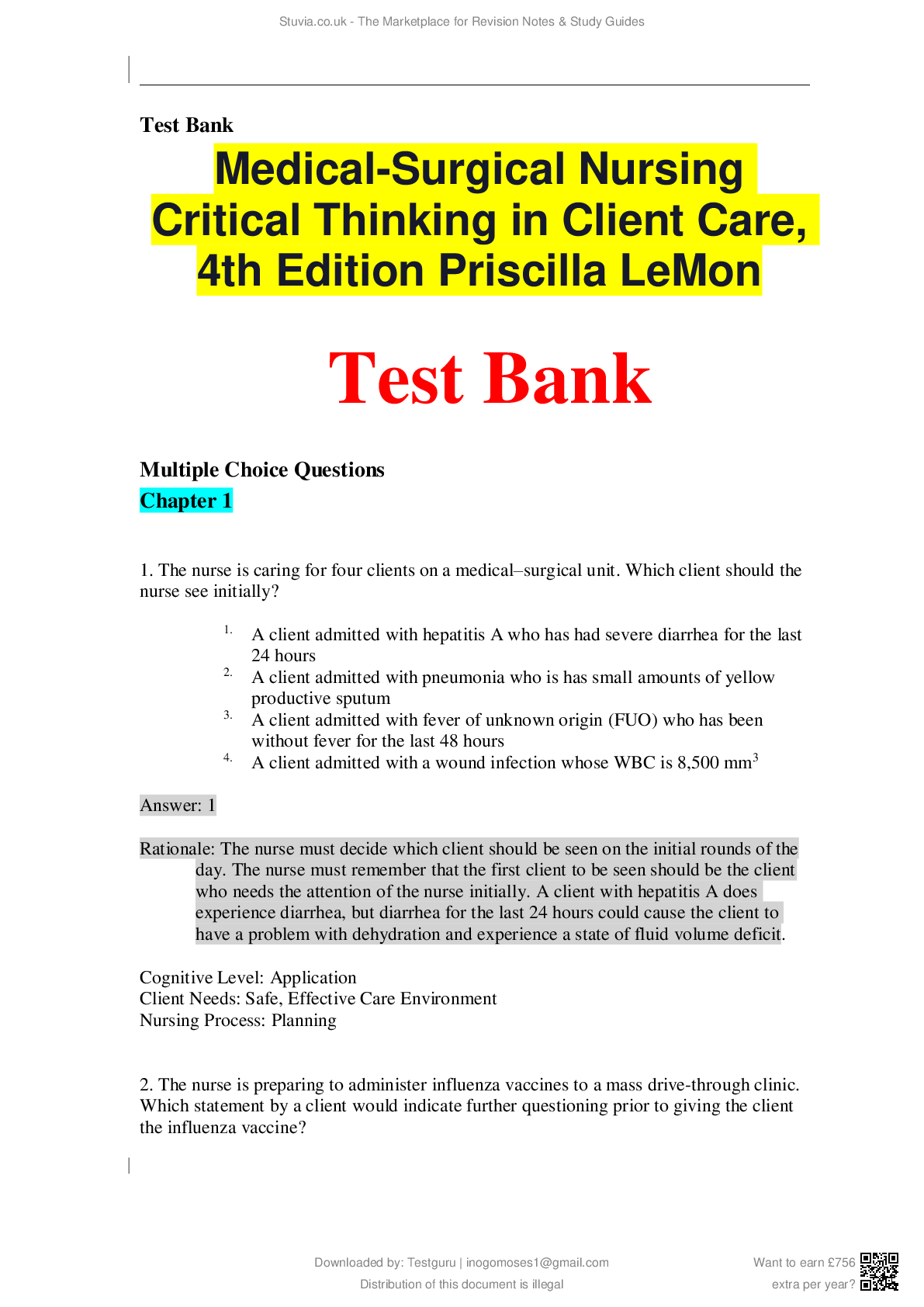*NURSING > TEST BANKS > ANATOMY_OF_OROFACIAL_STRUCTURES_8TH_EDITION_BY_BRAND (All)
ANATOMY_OF_OROFACIAL_STRUCTURES_8TH_EDITION_BY_BRAND
Document Content and Description Below
The sensation of pain is felt in which part of the tooth? a. Enamel b. Dentin c. Cementum d. Pulp ANS: D The dental pulp is the sensory and nourishing portion of the tooth. It is composed of blo... od vessels, lymph vessels, connective tissue, and nerve cells. The pulp also contains special dentin-reparative/formative cells called odontoblasts. Sensation of pain is not felt in enamel, cementum, or dentin. REF: pp. 15-17 OBJ: To identify the different tissues that compose teeth NAT: CDA: GC I.A.7. Identify basic oral and dental anatomy, physiology, and development, including but not limited to: teeth. TOP: BLOOM: Remembering 2. Each of the following terms refers to an “in-between” surface EXCEPT one. Which one is the EXCEPTION? a. Facial b. Mesial c. Distal d. Proximal ANS: A Proximal, mesial, and distal are terms that describe surfaces of teeth that face a neighboring tooth; they also can be thought of as “in-between” surfaces. Proximal is the more general term for this type of surface. More specifically, a mesial surface is the proximal surface of a tooth closest to the midline; distal describes the proximal surface farthest from the midline. Facial surfaces are NOT proximal surfaces. Facial surfaces are more specifically known as labial (lip) surfaces on anterior teeth or buccal surfaces on posterior teeth. REF: p. 19 OBJ: To define the terminology used in naming the landmarks of teeth NAT: CDA: GC I.A.7. Identify basic oral and dental anatomy, physiology, and development, including but not limited to: teeth. | CDA: GC I.C.2. Identify the surfaces of the tooth. TOP: BLOOM: Remembering 3. Which of the following is an example of a line angle? a. Mesiolabioincisal b. Buccolingual c. Mesiodistal d. Labioincisal e. Inciso-occlusal ANS: D Anatomy of Orofacial Structures 8th Edition Brand Test Bank Only the labioincisal description qualifies as a line angle because line angles separate two adjacent surfaces of a tooth by forming a junction. The labioincisal line angle represents the junction of the labial surface of an anterior tooth with its incisal edge; note these are two adjacent surfaces on anterior teeth. Buccolingual, inciso-occlusal, and mesiodistal junctions are not adjacent surfaces. A mesiolabioincisal line angle is not a line angle because it represents the junction of three adjacent surfaces and is thus a point angle. REF: pp. 17-19 OBJ: To name and identify the line angles of teeth NAT: CDA: GC I.A.7. Identify basic oral and dental anatomy, physiology, and development, including but not limited to: teeth. TOP: BLOOM: Remembering 4. The hard yellow tissue that makes up the bulk of the tooth is called the a. enamel b. dentin c. cementum d. pulp ANS: B Dentin is the hard, dense, calcified tissue that forms the greatest bulk of the tooth because it forms the largest portion of the crown and root. Softer than enamel, but harder than cementum or bone, the chemical composition of dentin is 70% inorganic and 30% organic matter and water. Unlike enamel, dentin is capable of adding to itself by producing reparative dentin. REF: p. 14 OBJ: To identify the different tissues that compose teeth NAT: CDA: GC I.A.7. Identify basic oral and dental anatomy, physiology, and development, including but not limited to: teeth. TOP: BLOOM: Remembering 5. All of the following formations are depressions EXPECT one. Which one is the EXCEPTION? a. Fossa b. Marginal ridge c. Developmental groove d. Lingual pit e. All of the above are depressions. ANS: B A ridge is an elevated portion of a tooth that runs in a line and is named for the specific location in which it occurs. Specifically, marginal ridges are the rounded borders of enamel that form the mesial and distal elevated shoulders of the occlusal surfaces of posterior teeth as well as the mesial and distal shoulders of the lingual surfaces of anterior teeth. Fossae, grooves, and pits are depressed formations within the tooth. They are also described as concavities, indented areas, or simply concave structures. A fossa is broadly defined as a depression or concavity. Developmental grooves are shallow, depressed lines that separate primary parts of the crown or root. A pit is a pinhole evident within a fossa or anywhere on a tooth. A lingual pit occurs on the lingual surface of a tooth. REF: pp. 21-24 OBJ: To name and identify the location of the various tooth surfaces NAT: CDA: GC I.A.7. Identify basic oral and dental anatomy, physiology, and development, including but not limited to: teeth. TOP: BLOOM: Remembering Anatomy of Orofacial Structures 8th Edition Brand Test Bank 6. The function of both incisors and premolars is to cut food. The function of molars is to cut, grind, and chew food. a. Both statements are true. b. The first statement is true; the second statement is false. c. The first statement is false; the second statement is true. d. Both statements are false. ANS: D Both statements contain incorrect information. While it is true that the function of incisors is to tear food, premolars are more like molars; their pointed buccal cusps hold food while the lingual cusps grind it. Regarding the second statement, the function of molars is to grind and chew food; tearing or incising is NOT a molar function. REF: pp. 17-18 OBJ: To understand the individual functions and therefore the individual differences that exist among incisors, canines, premolars, and molars NAT: CDA: GC I.A.7. Identify basic oral and dental anatomy, physiology, and development, including but not limited to: teeth. TOP: BLOOM: Remembering 7. The CEJ is where enamel meets the a. dentin b. junction c. cementum d. cervical third ANS: C Enamel and cementum meet at the cementoenamel junction (CEJ). The demarcating line is called the cervical line,formed by thIe juGnctiBon.oCf thMe cementum of the root and enamel of the crown. REF: pp. 11-12 OBJ: To differentiate between clinical and anatomic crowns and roots NAT: CDA: GC I.A.7. Identify basic oral and dental anatomy, physiology, and development, including but not limited to: teeth. TOP: BLOOM: Remembering 8. The dental tissue that most resembles bone is a. cementum b. dentin c. enamel d. none of the above ANS: A Cementum, a bonelike substance, contains 45% to 50% inorganic and 50% to 55% organic matter. Not as dense or as hard as enamel or dentin, cementum is more dense than bone and physiologically resembles bone. Cementum covers the root and provides a medium for the attachment of the tooth to the alveolar bone. REF: p. 16 OBJ: To identify the different tissues that compose teeth NAT: CDA: GC I.A.7. Identify basic oral and dental anatomy, physiology, and development, including but not limited to: teeth. TOP: BLOOM: Remembering 9. How many surfaces does a posterior tooth have? [Show More]
Last updated: 2 years ago
Preview 1 out of 14 pages
 (2).png)
Buy this document to get the full access instantly
Instant Download Access after purchase
Buy NowInstant download
We Accept:

Reviews( 0 )
$18.00
Can't find what you want? Try our AI powered Search
Document information
Connected school, study & course
About the document
Uploaded On
Sep 09, 2022
Number of pages
14
Written in
Additional information
This document has been written for:
Uploaded
Sep 09, 2022
Downloads
0
Views
83




 (1).png)

 (1).png)



 (1).png)













